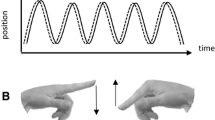Abstract
The objectives of this study were to examine the level of sensorimotor concepts of young autistic children and to relate these concepts to language comprehension. A sample of 16 autistic children with a mean mental age of 24.8 months was administered a standardized scale of sensorimotor intelligence and of receptive language. The autistic children demonstrated surprisingly sophisticated sensorimotor skills, particularly object permanence. While their initial performance was inferior to that of normal controls matched on mental age, particularly in their use of objects in combination, the difference between groups diminished on the second test administration. On the receptive language measure, the autistic children were less able to identify words correctly. The sensorimotor behavior of autistic children who demonstrated language comprehension did not differ from those who showed no language comprehension, except that the former group tended to use an object as an instrument somewhat more frequently. The fact that the autistic children were so impaired in language even with fairly good sensorimotor skills suggests that these skills, particularly object permanence, play a minor role in their language acquisition.
Similar content being viewed by others
Reference notes
Christ, A. E.Factors affecting the cognitive assessment of psychotic children arrested at at the sensorimotor stage of development. Paper presented at the American Academy of of Child Psychiatry, Toronto, 1977.
Escalona, S., & Corman, H.Albert Einstein scales of sensorimotor development. Unpublished manuscript, 1969.
References
American Psychiatric Association.Diagnostic and statistical manual of mental disorders (3rd ed.). Washington, D.C., 1980.
Anthony, T. Low grade psychosis in childhood. In B. W. Richards (Ed.),Proceedings of the London Conference for the Scientic Study of Mental Deficiency (Vol. 2). London: May & Baker, 1962.
Bates, E., Benigni, L., Bretherton, I., Camaioni, L., & Volterra, V.The emergence of symbols: Cognition and communication in infancy, New York: Academic Press, 1979.
Beckwith, L., & Thompson, S. K. Recognition of verbal labels of pictured objects and events by 17 to 30-month-old infants.Journal of Speech and Hearing Research, 1976,19, 690–699.
Bell, S. M. The development of the concept of the object as related to infant-mother attachment.Child Development, 1970,41, 291–311.
Bettelheim, B.The empty fortress;infantile autism and the birth of the self. New York: Free Press, 1967.
Casati, L, & Lezine, I. Les étapes de l'intelligence sensori-motrice. Paris: Les Editions de Centre de Psychologie Appliquée, 1968.
Corrigan, R. Language development as related to stage 6 object permanence development.Journal of Child Language, 1978,5, 173–196.
Corrigan, R. Cognitive correlates of language: Differential criteria yield differential results.Child Development, 1979,50, 617–632.
Curcio, F. Sensorimotor functioning and communication in mute autistic children.Journal of Autism and Childhood Schizoprhenia, 1978,8, 282–292.
Decarie, T. G.Intelligence and affectivity in early childhood. New York:International Universities Press, 1967.
DeMyer, M. K., Alpern, G. D., Barton, S., DeMyer, W. E., Churchill, D. W., Hingtgen, H. N., Bryson, C. O., Pontius, W., & Kimberlin, C. Imitation in autistic, early schizophrenic, and non-psychotic subnormal children.Journal of Autism and Childhood Schizophrenia, 1972,2, 264–287.
Fish, B. The recognition of infantile psychoses. In M. Howells (Ed.),Modern perspectives in the psychiatry of infancy. New York: Brunner/Mazel, 1979.
Kopp, C. B., Sigman, M., & Parmelee, A. H. Ordinality and sensory-motor series.Child Development, 1973,44, 821.
Kopp, C. B., Sigman, M., & Parmelee, A. H. Longitudinal study of sensorimotor development.Developmental Psychology, 1974,10, 687–695.
Mahler, M. S., Pine, F., & Bergman, A.The psychological birth of the human infant. New York: Basic Books, 1975.
Nelson, K. Structure and strategy in learning to talk.Monographs of the Society for Research in Child Development, 1973,38 (1–2, Serial No. 149).
Piaget, J.The origins of intelligence in children. New York: Norton, 1952.
Rutter, M. Diagnosis and definition. In M. Rutter & E. Schopler (Eds.),Autism; A reappraisal of concepts and treatment. New York: Plenum Press, 1978.
Serafica, F. C. Object concepts in deviant children.American Journal of Orthopsychiatry, 1971,41, 473–482.
Ungerer, J., & Sigman, M.Symbolic play and language comprehension in autistic children. Journal of the American Academy of child psychiatry, in press.
Uzgiris, I. C. Organization of sensorimotor intelligence. In M. Lewis (Ed.),Origins of intelligence. New York: Plenum, 1976.
Uzgiris, I. C., & Hunt, J. McV.Assessment in infancy. Urbana: University of Illinois Press, 1975.
Wing, L., Gould, J., Yeates, SR., Brierly, L. M. Symbolic play in mentally retarded and in antistic children.Journal of child Psychology and Psychiatry, 1977,18, 167–178.
Wolf, D., & Gardner, H. On the structure of early symbolization. In R. Schiefelbush & D. Bricker (Eds.),Early language intervention. Baltimore: University Park Press, in press.
Author information
Authors and Affiliations
Additional information
Support for this research was provided by Biobehavioral Research Support Grant 516, Grant 12–41 from the March of Dimes, NIMH Postdoctoral Fellowship No. 1 F32 MH07550-01 (Ungerer), and NIMH Grant MH 33815-01. Subjects were recruited from the UCLA Research Center for the Study of Childhood Psychosis, funded by NIMH Grant MH 30897. We would like to thank members of the CRC, particularly Dr. Peter Tanguay, Dr. Barbara Fish, and Dr. B. J. Freeman, for their support of our research efforts.
Rights and permissions
About this article
Cite this article
Sigman, M., Ungerer, J. Sensorimotor skills and language comprehension in autistic children. J Abnorm Child Psychol 9, 149–165 (1981). https://doi.org/10.1007/BF00919111
Revised:
Issue Date:
DOI: https://doi.org/10.1007/BF00919111




